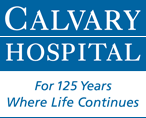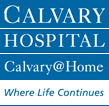End of life care is a difficult topic for many. Few among us are comfortable talking about it, and even fewer filmmakers look to cover it. But Defining Hope, a groundbreaking documentary by filmmaker Carolyn Jones does so in a way that opens the doorway to conversation through skilled and sensitive storytelling.
Defining Hope follows patients with life-threatening illness as they make choices about how they want to live their lives, what medical interventions they will pursue or accept, and what their hopes and priorities are, all in the face of life-limiting illness.
The film serves as reminder to viewers of the choices we still have in how we live and how we die, while shining light on the importance of making advanced directives known to our loved ones well before they’re actually needed.
Staff and patients of Calvary Hospital are among several hospitals and care facilities featured in this documentary on end-of-life decision-making.
A special spotlight is focused on Calvary Hospital Diane Ryan, RN. Documentary viewers see Ryan, who is receiving treatment for her own cancer, as she works, providing care to patients at Calvary Hospital while living with her own illness.
In the film, Ms. Ryan shares her honest thoughts and perspective on caring for patients and their families, and being a hospice nurse, all while dealing with serious health challenges. She also shows the importance of humor for those with illnesses, as well as for those serving in her role.
At one point, the documentary shows Ryan’s joy as she finishes a grueling 40 mile bike ride around New York City. “I’m not afraid to die,” she says in the voice-over. “I’ve never been afraid to die. It’s how we’re going to die, and I don’t think I want to be on a bed sick as a dog.”
This is actually the second project by award-winning documentary filmmaker Carolyn Jones and her crew to highlight Calvary Hospital. Jones had previously led a multimedia project called Dying in America: Nurses Leading the Conversation. That project also included interviews with nurses delivering end-of-life care, and resources for people making end-of-life decisions, all now posted on a website: dyinginamerica.org/about/.
It was working on that project which led to Defining Hope. Barbara J. Nitzberg, who directs public affairs and community relations for Calvary Hospital, said the hospital was drawn to Jones’ Dying in America project and agreed to be part of the Defining Hope film because Jones’ philosophy aligns with that of the hospital.
Nitzberg said, “We recognized that we had the opportunity to work with a partner who wanted to show another side of the end-of-life experience — that this sacred time, one that can be very life-affirming and joyful, not just a time of sadness.”
Jones saw through working with Calvary Hospital on the Dying in America project that Calvary was skilled in addressing patients’ end-of-life needs in a holistic way.
Calvary’s Nitzberg said, “We hope that when people see Defining Hope, they will better understand that we all have choices in how we want to live. How we die is one of the choices we can influence, if we are fortunate and if we plan. After people see the film, we hope they will decide to make advanced directive plans well ahead of time.”
She added, “Calvary wants to help shape the national conversation on end-of-life care and what we need to do to improve it for all Americans.”
As the population rapidly ages and challenges in end-of-life care become even more prevalent, Defining Hope will continue to be a valuable source of information, inspiration, and hope.
The film was screened in theaters in cities across the U.S., and is now available on DVD, digital television through On Demand, and aired its debut on PBS stations in April. To learn more, please visit: http://hope.film/. To see a trailer of the film, go to http://hope.film/trailer/.
Categories
Archives
- June 2025
- May 2025
- April 2025
- March 2025
- February 2025
- October 2024
- August 2024
- July 2024
- May 2024
- April 2024
- March 2024
- February 2024
- December 2023
- November 2023
- October 2023
- August 2023
- July 2023
- June 2023
- May 2023
- April 2023
- March 2023
- January 2023
- December 2022
- October 2022
- August 2022
- July 2022
- June 2022
- April 2022
- March 2022
- February 2022
- January 2022
- October 2021
- September 2021
- August 2021
- July 2021
- June 2021
- May 2021
- April 2021
- March 2021
- February 2021
- December 2020
- November 2020
- October 2020
- September 2020
- August 2020
- July 2020
- May 2020
- April 2020
- March 2020
- February 2020
- January 2020
- December 2019
- November 2019
- October 2019
- September 2019
- August 2019
- July 2019
- May 2019
- April 2019
- March 2019
- February 2019
- January 2019
- December 2018
- November 2018
- October 2018
- September 2018
- August 2018
- July 2018
- June 2018
- May 2018
- April 2018
- December 2017
- November 2017
- October 2017
- September 2017
- August 2017
- July 2017
- June 2017
- May 2017
- April 2017
- April 2012

